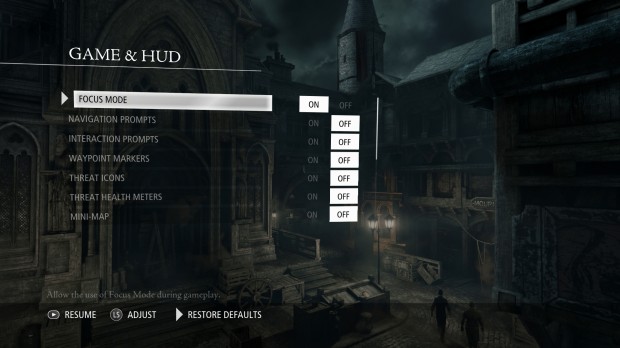There are games that define a genre. Ultima Online and Everquest defined MMOs for decades to come, Mario gave us platformers, Wolfenstein 3D ushered in the first-person shooter, and Thief was the genesis of the stealth game. The concept of taking your time, stuffing everything that wasn’t bolted down into your pockets, and disappearing into the darkness was something completely new. Unfortunately, Master Thief Garrett has remained in the shadows for the last ten years.
Eidos Montreal, creators of the successfully relaunched Deus Ex: Human Revolution also took on the ambitious job of reimagining the classic Thief series to bring it to a new generation of gamers. Immediately there was concern that they’d make it more of an action title to appeal to the twitch gamers of today. Early showings of the game gave purists pause as it featured a lot of new elements that didn’t quite match the classic title. Reports of problems with the studio rumbled to the surface, making me very worried about this reboot of my favorite franchise.
After a 20GB download I prepared for my walk through the shadows. Once again we are placed into the soft leather boots of Garrett, Master Thief. He returns to The City after an unexplained hiatus, briefly joined by a fellow footpad Erin, the young girl that tried to pickpocket Garrett at the end of The Dark Project. When a job goes sideways, Garrett settles back into his solitary ways, relieving the wealthy of their precious and shiny baubles and coin. But there is more to this botched job, and only by fully fleecing The City will Garret uncover his role in it.
“Some people in this city are too rich for their own good. Luckily they have me to give them a hand”
The game kicks off with an option of four difficulty levels, of sorts. Rogue offers less aware opponents with low resource costs and plentiful loot, whereas Thief is the normalized game with competent and aware guards and balanced valuable prices. Master cranks it up to a purist level where civilian kills and knockouts are not tolerated, and upgrades are prohibitively expensive. Custom is where true sadists can hone their craft, allowing you to mod your game to make it more difficult. Options include removing the reticules, locking out all upgrades, removing the ability to save other than at the end of the chapter, removing the Focus or Swoop ability, and much more. If you want an extreme challenge, or want to remove elements that break your immersion, this is your setting. Setting the game difficulty is only available from the start though – you can’t change your difficulty level once you’ve begun.

Early demonstrations of the game, included a guided E3 demo pointed to overly short level design. I can assure you that this is not the case. While the first mission took me 25 minutes (and I missed 30% of the loot), every main mission after that took me roughly an hour with a large chunk of goodies left undisturbed. After mission four you’ll also meet up with your old fence Basso who offers up 16 side missions, and you’ll find a few other client jobs scattered here and there. I didn’t have a great deal of time to really dig into each level before launch, but there is easily north of 15 hours of content begging to be uncovered, and that’s not including the vast wealth of unique collectables waiting for you.
Within your clock tower hideout is a set of empty collector’s cases, their felt backs eager to be filled with the elite’s most precious goods. These unique collectables range from masks, bracelets, and brooches to district nameplates you’ve literally unscrewed right off the walls. If you want to find every scrap of lore that also means means 208 documents, in addition to the 82 unique shinies mentioned above.
After every main mission you’ll receive a grade of sorts, describing your performance and labeling you as an Opportunist, Ghost, or Predator. Opportunists make more use of the environment (secret passageways, using the dark, etc.) and Predators spend their time shooting arrows into unsuspecting throats. Ghosts are the true masters, casing and looting a joint without leaving a single trace that they were ever there – the most difficult of challenges. The mission summary also gives you a breakdown of any thieving challenges for that level, the amount of loot you’ve found or missed, the number of times you were detected or disturbed the scene enough to bring about suspicion. Given that you only have one save file (which is overwritten periodically at checkpoints in addition to your manual saves), you’ll have to move slowly and with purpose.

“Never trust a talking rock. Someone might lose an eye.”
Picking locks is a major part of a thief’s line of work. Garrett is able to pop a lock by circling the left stick and then setting the pin with the right trigger. Unlike previous titles (or other games in the genre that use this mechanic) the ‘butter zone’ for pushing the tumblers into position is far smaller as the locks become more complex, eventually being mere millimeters. If you’ve upgraded your Sense skill you can also see inside the lock while using your Focus power, giving you a visual representation of the tumblers being slid into place with your lockpick. It’s pretty cool visually, though I really didn’t feel the need to use this view except to exploit the added bonus that it slows down time slightly.
Occasionally you’ll find secret vaults that require your unique attention. Early versions of the game allowed players to use the touch pad on the PS4 controller to ‘feel’ the haptic feedback of your fingers crossing a button. In the final version you’ll do this by just rolling the left stick and clicking the button with a trigger, just like picking a lock. I imagine this is due to the finicky nature of the DualShock 4 touchpad more than anything.
There is a feature that is unique to the PlayStation 4 version of the game, and that’s the use of the light on the front of the controller. I encourage you to play Thief in the dark as this simple light surprisingly adds a great deal to the game. When you are obfuscated by the cloak of darkness the controller light remains blue, but when you are illuminated by a nearby fire it gets slightly brighter, flickering with the light source. Step directly into a well-lit area and the light turns completely white and drowns the entire room with brightness. This small feature creates a tremendous amount of immersion.

As Garrett explores The City, he’ll encounter a character named the Queen of Beggars. Giving donations to her cause lets Garrett earn “Focus Points”. These allow you to upgrade one of eight areas — Intuition, Dexterity, Sense, Combat, Speed, Efficiency, Marksmanship, and Stealth. While some of those are fairly obvious, an upgrade to Intuition highlights objects of importance from a distance, and a second upgrade allows you to follow a trail of hand prints to find unique loot and collection items. Dexterity allows you to pickpocket multiple items at once, whereas a second upgrade allows you visualise the inside of a lock as I mentioned above. Sense gives Garrett the ability to visually see how much noise he or others are making from a distance. There are a bevy of combat upgrades too, but I completely ignored those. All in all, I treated these upgrades as most people will – optional. Thankfully none of them give Garrett “super powers” or anything that breaks canon, but none of them are absolutely necessary either.
There is one new skill that does make this game a bit more approachable to a new audience – Focus. This ability allows Garrett to spot things that are ‘of interest’, such as candles to blow out, valuable objects, climbable surfaces, and much more. This reminded me heavily of the “Detective Mode” in the recent Batman games, and with the same results – it makes it too easy. Focus allows you to rapidly identify everything that you can interact with, but that removes the fun of exploration. I used Focus very sparingly, but in a world where most people don’t finish the games they purchase, I can understand why it exists.
Garrett does come with one other new ‘power’, of sorts – the ability to “swoop”. This move allows the master thief to quietly dash from shadow to shadow, making very little noise in the process. One of the mods turns this ability off, but it is a neat addition. It does allow the player to move more swiftly through a darkened room than you could in previous games, but you can just as easily swoop directly into danger as you can out of it. Overuse will force Garrett to have to rest a bit before using it again, which can leave you stranded in a well lit area with no means of escape. It’s different, but it grows on you the more you use it.

“Hey, the city looks almost bearable from up here”
I have to take a moment and tip my hat to lead level designer Daniel Windfeld Schmidt and his crew. Those of us who enjoyed the hair-raising Shalebridge Cradle level in Thief: Deadly Shadows have something very exciting to look forward to here – The Asylum. The Asylum is a masterstroke of suspenseful and creepy level design and storytelling, and more than once made me jump. I found myself subconsciously putting my back against the wall and looking around every corner. It’s not like it did any good, either, as objectives like “Descend to the treatment level” are as ominous as they are accurate.
I also have to commend the team for their use of traps. Many games overuse traps, forcing the player to spend more time looking at their feet than the world the developers crafted. In Thief, traps are used sparingly ensuring that when you do encounter them they come as a surprise, making them far more effective and doubly dangerous.
The one thing that isn’t particularly dangerous is the AI. The guards tend to follow very strict patrol routes, make comments about things being ‘out of place’ when you’ve stolen them but do very little investigation, and are generally about the same intelligence we saw in previous games. It’s never been particularly difficult to get away once you are spotted, but Thief is more about not being caught in the first place. That’s not an excuse for a predictable AI, though.
Thief, despite its delays, comes in with a few cosmetic flaws. The Unreal engine shines bright here, painting a beautiful world for Garrett to inhabit, but there are very slight hitches in the first few cutscenes (though these seem to iron themselves out for later levels). Similarly, the subtitles de-synch from the action in these early interactions. Chapter 6 features some pretty intense elements, and as such the framerate suffers. Thankfully neither of these things are particularly impactful. Additionally there are some audio levelling issues within cutscenes, alongside some odd clipping bugs. Though none of these compares to the voice overlapping issues.
Like a great many open world games, NPCs chatter constantly. In smaller areas like a bar their chatter overlaps a great deal, sometimes completely obscuring the conversation you are trying to have with the person in front of you. As you roam around the open world of The City you’ll also hear a great deal of line repetition amongst the citizenry. One particular exchange regarding a local favorite prostitute was on a permanent 20 second loop. Speaking of voices…

“This hallway is too well lit, I better put a water arrow into that torch”
Stephen Russell provided the slick and gravelly voice of Garrett for the last three games. Ultimately the team at Eidos Montreal felt that they needed to do vo-cap (voice and motion at the same time) with a new actor as the movements and facial expressions of the actors would create a more “convincing experience”. Veteran actor Romano Orzari was chosen as his replacement. While Orzari does a commendable job as Garrett, there is absolutely nothing in this game that required the replacement of Russell. Most of the time you’ll hear Garrett’s disembodied voice while you are looking at your extended hands in the crouched position.
The cutscenes in previous Thief titles had a particular flavor to them. They’d start with a quote that helped to add backstory to the dark world and then proceeded into a hand-drawn animation style that bordered on surreal papercraft cutouts. They conveyed dread and darkness in their heavily shaded presentation and were a great part of the storytelling in the world of Thief. The cutscenes in this title are the more traditional interactions, using the engine to deliver story elements. This was likely to help prevent the feeling that the levels were separate compartments, but part of a larger and more seamless world. I’m not going to say that I wasn’t a little disappointed that these were gone, but I understand the decision.
There are some great subtle throwbacks to previous games in the Thief franchise. Garrett retains his mechanical eye, you’ll encounter what looks like an old Hammerite cathedral from The Dark Project, and you’ll even hear one person insult another by calling them a taffer. Similarly, the return of the rope arrow enables the verticality and exploration elements that were somewhat lost in Deadly Shadows. Mechanical marvels come up in a side mission, nodding to the events of The Metal Age. The team clearly has deep roots into the previous games, and this reboot serves as a solid canvas in which to paint a new tapestry for Garrett.
Ron Burke is the Editor in Chief for Gaming Trend. Currently living in Fort Worth, Texas, Ron is an old-school gamer who enjoys CRPGs, action/adventure, platformers, music games, and has recently gotten into tabletop gaming.
Ron is also a fourth degree black belt, with a Master's rank in Matsumura Seito Shōrin-ryū, Moo Duk Kwan Tang Soo Do, Universal Tang Soo Do Alliance, and International Tang Soo Do Federation. He also holds ranks in several other styles in his search to be a well-rounded fighter.
Ron has been married to Gaming Trend Editor, Laura Burke, for 28 years. They have three dogs - Pazuzu (Irish Terrier), Atë, and Calliope (both Australian Kelpie/Pit Bull mixes), and an Axolotl named Dagon!

Despite my deep reservations regarding the reboot of my favorite character and the world he inhabits, Thief manages to deliver a compelling experience. Sure it’s a bit grimy in areas, but the team at Eidos Montreal have done well with the reboot of this title, just as they did for Deus Ex. The main missions are immersive, and the team has clearly catered to both new audiences and us old taffers with the bevy of options and mods. While it may not convey the same style as its forerunners, it delivers what I would call a mostly-authentic Thief experience. Now, let’s talk about getting those cutscenes back…
PROS
- Level design is solid. The Asylum level is perfection!
- Being stealthy is still fun
- Beautiful graphical presentation
- Custom difficulty setting is superb
- Nods to prior Thief titles
CONS
- Focus ‘dumbs down’ the exploration element
- Voice repetition, voice repetition, voice repetition
- Frequent loading between areas
- AI is a little dense
- Story doesn’t explain where this game fits
See below for our list of partners and affiliates:

























